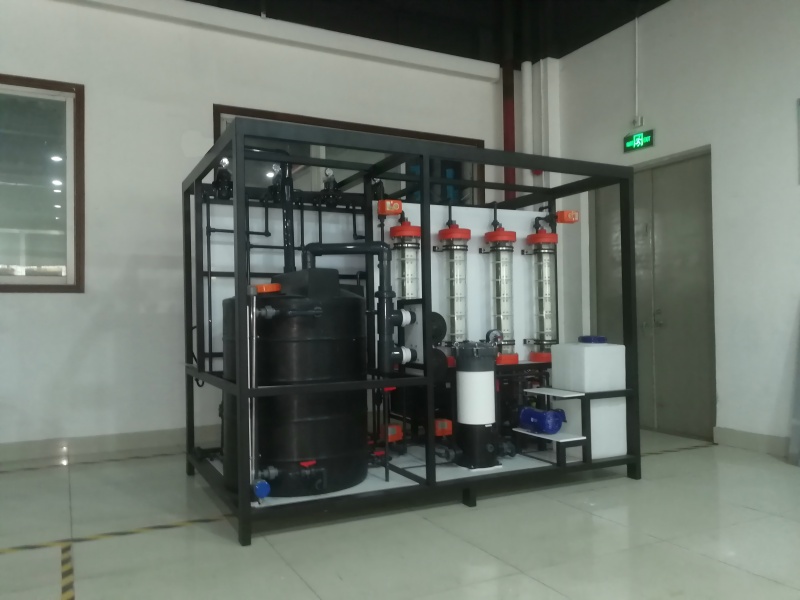
Seawater Electrolysis Chlorine Generation for Cooling Tower Biofouling Control

Seawater electrolysis for chlorine generation is an efficient and environmentally friendly technology widely used in industrial settings requiring seawater cooling, such as coastal power plants and chemical plants.
1. Technical Principle
Seawater electrolysis generates sodium hypochlorite (NaClO) by electrolyzing sodium chloride (NaCl) present in seawater. Sodium hypochlorite is a strong oxidizing agent that effectively kills bacteria, algae, and other microorganisms in cooling water systems, preventing biofouling and clogging.
Chemical Reactions:
Anode Reaction: 2Cl⁻ → Cl₂ + 2e⁻
Cathode Reaction: 2H₂O + 2e⁻ → H₂ + 2OH⁻
Sodium Hypochlorite Formation: Cl₂ + 2NaOH → NaClO + NaCl + H₂O
Bactericidal Mechanism: Sodium hypochlorite decomposes in water to form hypochlorous acid (HClO), which has strong oxidizing properties capable of destroying microbial cell structures, achieving the effect of sterilization and algae removal.
2. Application Cases
(1) Coastal Power Plant Cooling Systems
Coastal power plants often use seawater as a cooling medium. However, seawater contains vast amounts of microorganisms and algae, which readily form biological fouling within the cooling system. Electrolytic chlorine generation from seawater effectively controls this biological contamination. Examples include:
One coastal power plant implemented this technology, dosing the sodium hypochlorite solution into the cooling tower circulating water and maintaining a residual chlorine concentration of 0.3-0.5 mg/L. This successfully inhibited marine organism growth, reducing system blockages and corrosion issues.
In another case, a power plant validated the bactericidal effect through dynamic simulation tests, showing that sodium hypochlorite achieved a kill rate exceeding 90% against marine organisms.
(2) Industrial Cooling Towers
Cooling tower circulating water systems in industries like chemical and metallurgy also frequently face microbial contamination problems. Seawater electrolysis technology is widely applied in these areas due to its high efficiency and low cost.
A chemical plant utilized a plate-type electrolyzer to electrolyze seawater, directly dosing the generated sodium hypochlorite into the cooling tower. This significantly reduced microbial contamination while decreasing the usage of other chemical biocides.
Another case involved a factory optimizing the electrolyzer design (e.g., using titanium-based electrodes), which improved sodium hypochlorite production efficiency and lowered operating costs.
3. Technical Advantages
Environmental Friendliness: No need for additional chemical additives, reducing secondary pollution.
Economic Efficiency: Seawater is an abundant resource, leading to low operating costs, particularly suitable for coastal regions.
High Efficiency: Sodium hypochlorite offers significant bactericidal effects, enabling rapid control of microbial contamination.
High Automation Level: Automation achievable via PLC systems, allowing real-time monitoring of residual chlorine concentration and adjustment of electrolysis current.
4. Technical Challenges & Solutions
(1) Electrode Corrosion
Problem: High salinity and corrosive substances in seawater accelerate electrode corrosion.
Solution: Use corrosion-resistant materials (e.g., titanium-based ruthenium-iridium oxide coated electrodes) and optimize electrolyzer design.
(2) Residual Chlorine Control
Problem: Excessively high residual chlorine concentration can cause equipment corrosion, while insufficient levels fail to effectively sterilize.
Solution: Install residual chlorine sensors integrated with an automated control system to adjust the dosing rate in real-time.
(3) Electrolysis Efficiency
Problem: Electrolysis efficiency is affected by seawater salinity, temperature, and current density.
Solution: Optimize electrolyzer structure (e.g., using plate-type electrolyzers) to improve current efficiency and sodium hypochlorite yield.
5. Sodium Hypochlorite Demand Calculation
The dosage of sodium hypochlorite is typically determined based on the target residual chlorine concentration in the cooling tower water. A concentration of 0.3-0.5 mg/L (ppm) is generally effective for sterilization and algae control.
Sodium Hypochlorite Dosage Calculation:
Cooling Tower Seawater Flow Rate: 48,000 m³/h
Target Residual Chlorine Concentration: 0.5 mg/L
Dosage required to achieve residual: 1 mg/L (Assumed based on system consumption/decay)
Sodium Hypochlorite Dosage = (48,000 m³/h × 1 mg/L) = 48 kg/h
Therefore, the required dosage rate of sodium hypochlorite solution is 48 kg/h.
Electrolyzer Design
The electrolyzer design is based on the sodium hypochlorite production rate and seawater flow.
(1) Electrolyzer Capacity
Effective Chlorine Production Rate: 48 kg/h
(2) Electrolyzer Structure
Electrode Material: Anode - Titanium-based ruthenium-iridium oxide coating (Ti/RuIrOx); Cathode - Titanium-based platinum coating or stainless steel.
Electrolyzer Type: Plate-type electrolyzer, facilitating maintenance and cleaning.
Number of Electrolyzers: Multiple units can be designed to operate in parallel based on actual requirements, enhancing system flexibility and reliability.
Power Supply Design
Use DC power supply with constant current or constant voltage regulation capability.
The power supply system should include overload and short-circuit protection.
Sodium Hypochlorite Dosing System
Dosing Method: Directly inject the electrolytically generated sodium hypochlorite solution into the cooling tower's inlet water pipeline.
Dosing Equipment:
Use metering pumps to automatically adjust the dosage based on the residual chlorine concentration.
Install residual chlorine sensors for real-time monitoring of the concentration in the cooling tower water.
Automated Control System
Control Objectives:
Automatically regulate the electrolyzer current and sodium hypochlorite dosage based on the residual chlorine concentration in the cooling tower water.
Monitor the operating status of the electrolyzer (e.g., current, voltage, temperature) to ensure safe system operation.
Control Equipment:
Implement a PLC (Programmable Logic Controller) system for automated control.
Install an HMI (Human-Machine Interface) for easy operator monitoring and parameter adjustment.
Safety Measures
Chlorine Leakage Protection:
Install chlorine leakage detectors around the electrolyzer and dosing system.
Ensure the electrolyzer is sealed properly to prevent chlorine gas leakage.
Hydrogen Emission:
Safely vent the hydrogen gas produced during electrolysis using a ventilation system.
Explosion-Proof Design:
The electrolyzer and power supply system should possess explosion-proof features to prevent hydrogen accumulation and potential explosions.
Operation & Maintenance
Regular Electrode Cleaning:
Clean the electrodes every 3-6 months to prevent scaling and fouling buildup.
Regular System Inspection:
Inspect the operating status of the electrolyzer, power supply, metering pumps, etc., to ensure normal system operation.
Recording & Analysis:
Record system operational data (e.g., current, voltage, residual chlorine concentration) and periodically analyze system performance.
Summary
Seawater electrolysis for chlorine generation is an efficient and environmentally friendly method for disinfecting and controlling algae in cooling towers. It has been widely adopted in coastal power plants, chemical plants, and other fields. By optimizing electrolyzer design, enhancing automation levels, and integrating with other water treatment technologies, its economic viability and applicability can be further improved.
